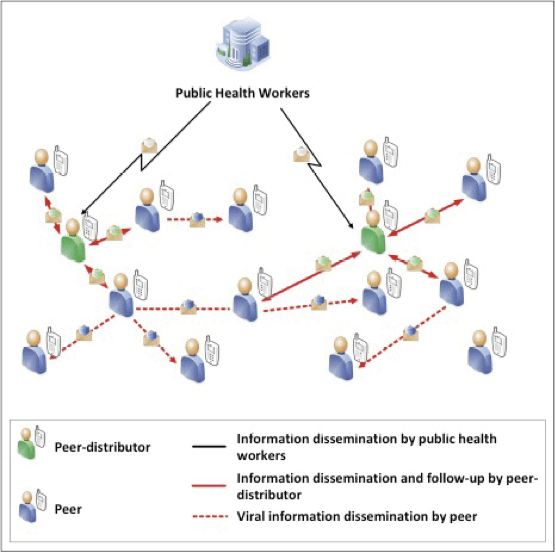By Ekkehard Beck and Benjamin Armbruster, PhD
Social network analysis is increasingly used to describe, visualize and model existing real-world networks in order to better understand various structural and relational aspects in public health [1]. For example, Figure 1 shows a cell-phone network of Indian men who have sex with men (MSM). Data about social, commuter, and transportation networks allows one to more accurately simulate the spread of a disease outbreak and to evaluate different intervention scenarios to determine an optimal strategy for disrupting disease transmission. A recent example using this method is a model predicting the H1N1 outbreak in the US in 2009 [2].

Figure 1: Network of cell-phone contacts among 4891 Indian men who have sex with men (MSM), Hyderabad, India. 241 Indian MSM were interviewed (red) and named their cell-phone contacts (white) [31, 32]. This figure was created using Gephi [33].
Social network analysis and public health interventions
One example of a network-based public health intervention is contact tracing [3], which involves finding and testing the contacts of newly diagnosed individuals (a.k.a. the index case). Contact tracing is a common tool used for human immunodeficiency virus (HIV) and sexually transmitted diseases (STD) case tracking, as well as for controlling tuberculosis (TB) outbreaks. While these cases may be hard to identify, contact tracing is useful here because contacts of an index case are at high risk of infection [4, 5].
Using online social networks such as Facebook [7], interventions promoting physical activity [8] and targeting STDs [9] can quickly reach a broad audience at a low cost. Social networks allow for ‘viral’-like spread of the intervention among the target population, leading to a wider reach of the intervention and greater effectiveness due to peer-influence [7, 10]. Messages, pictures, and videos can spread virally through a community e.g. by word-of-mouth referral and forwarding of text messages (SMS) and emails, which mimics the spread of a virus from person to person.
Social network analysis is also useful for identifying opinion leaders to target for behavior change campaigns [6]. After surveying community members to construct a social network matrix, opinion leaders can be identified using network centrality measures. These centrality measures include degree (the number of social contacts and a measure of popularity), closeness centrality (those in the center of the network, with few ‘hops’ between them and everyone else in the target population), and betweenness centrality (those playing a ‘broker’ or ‘bridge’ role by connecting different parts of the network) [3, 6].
Our current research aims to show how actual social networks and social network analysis can be incorporated into the design of behavioral prevention interventions using text messaging. Mobile phones have a penetration of 96% globally [11] and text messages (SMS) are the most popular non-voice application [12]. Text messages are increasingly used as a primary means of communication for promotion and education about sexual and reproductive health [13, 14], physical activity [15, 16], smoking cessation [17, 18] and mental health [19]. These interventions either push out bulk messages to a large number of users [20, 21] or require public health workers to recruit participants who then receive individually tailored text messages [22]. Both types are challenged by either ‘reach’ or ‘richness’, i.e. the number of participants reached or the quality of information transmitted [23], where low quality information impacts acceptance and retention rates [24, 25].
Peer-to-peer text messaging and peer education
Peer-to-peer (P2P) text messaging is a new mobile-phone based intervention designed to increase the reach and richness of behavioral prevention interventions, by having participants directly communicate with and educate peers via text messages. Public health workers recruit and train peer-distributors among the target population. Peer-distributors receive prevention content from public health workers and text the intervention messages to their peers by leveraging their cell-phone network. Text messages are tailored to the individual characteristics and needs of each peer. Peers can follow-up with the peer-distributor and can in turn forward the received messages to their peers. See Figure 2.
In our current research, we use a simulation framework and network datasets, such as in Figure 1, to compare the proposed P2P text messaging design against other intervention designs currently used, such as bulk message interventions and personalized interventions. We reason that leveraging the peer-distributor’s social network and phone contacts, with the ability to tailor messages individually and then follow-up on these messages with his peers, will increase the richness of the information conveyed, resulting in a higher acceptance of the messages [26, 27]. Additionally, this approach will, especially for targeted campaigns, reach more individuals at lower cost than public health workers recruiting participants for individually tailored text messaging studies; this effect is being observed in peer-driven interventions among HIV-infected injection drug users [28, 29]. Simulating the spread of information and behavior change in social networks allows us to determine how to best tailor such a text message based intervention in different contexts [30]. P2P text messaging also allows for the dissemination of information and awareness to become viral; a recent idea in marketing whose full impact has not yet been explored by the public health community. Social networks and text messaging are becoming more important for prevention interventions and there is much to be gained by utilizing social network data and analysis in the design of existing prevention interventions.
References
- Luke, D.A. and J.K. Harris, Network analysis in public health: history, methods, and applications. Annu Rev Public Health, 2007. 28: p. 69-93.
- Research on Complex Systems. Engineering Sciences and Applied Mathematics, N.U. Computational quanti- tative projections for H1N1 flu dynamics in the United States. 2009 [cited 2014 01/25]; Availa- ble from:http://rocs.northwestern.edu/projects/ swine_flu/.
- Valente, T.W., Network interventions. Science, 2012. 337(6090): p. 49-53.
- Armbruster, B. and M.L. Brandeau, Contact tracing to control infectious disease: when enough is enough. Health Care Management Science, 2007. 10(4): p. 341-355.
- Armbruster, B., et al., Exploring the relative costs of contact tracing for increasing HIV case finding in sub-Saharan countries. J Acquir Immune Defic Syndr, 2011. 58(2): p. e29-36.
- Valente, T.W. and P. Pumpuang, Identifying opinion leaders to promote behavior change. Health Educ- Behav, 2007. 34(6): p. 881-96.
- Cobb, N.K. and A.L. Graham, Health behavior inter- ventions in the age of facebook. Am J Prev Med, 2012. 43(5): p. 571-2.
- Cavallo, D.N., et al., A social media-based physical activity intervention: a randomized controlled trial. Am J Prev Med, 2012. 43(5): p. 527-32.
- Bull, S.S., et al., Social media-delivered sexual health intervention: a cluster randomized controlled trial. Am J Prev Med, 2012. 43(5): p. 467-74.
- Scharl, A., A. Dickinger, and J. Murphy, Diffusion and success factors of mobile marketing. Electronic Commerce Research and Applications, 2005. 4(2): p. 159-173.
- Division, I.T.U.I.D.a.S., The World in 2013: ICT Facts and Figures. 2013: Geneva, Switzerland.
- Lenhart, A., Cell phones and American Adults. Pew internet & American life project. 2010: Washington, D.C., USA.
- Delamere, S., et al., Safer sex text messages: Evalu- ating a health education intervention in an adolescent population. Sexually Transmitted Infections, 2006. 82: p. A27-A27.
- Levine, D., et al., SEXINFO: a sexual health text messaging service for San Francisco youth. Am J Public Health, 2008. 98(3): p. 393-5.
- Prestwich, A., M. Perugini, and R. Hurling, Can imple- mentation intentions and text messages promote brisk walking? A randomized trial. Health Psychol, 2010. 29(1): p. 40-9.
- Sirriyeh, R., R. Lawton, and J. Ward, Physical activity and adolescents: an exploratory randomized con- trolled trial investigating the influence of affec- tive and instrumental text messages. Br J Health Psychol, 2010. 15(Pt 4): p. 825-40.
- Haug, S., et al., Continuous individual support of smoking cessation using text messaging: a pilot experimental study. 2009. 11(8): p. 915-23.
- Rodgers, A., et al., Do u smoke after txt? Results of a randomised trial of smoking cessation using mobile phone text messaging. 2005. 14(4): p. 255-61.
- Pijnenborg, G.H., et al., The efficacy of SMS text messages to compensate for the effects of cognitive impairments in schizophrenia. Br J Clin Psychol, 2010. 49(Pt 2): p. 259-74.
- Gold, J.A., C.K.; Dixon, H.G.; Lim, M.S.C.; Gouillou, M.; Spelman, T.; Wakefield, M.; Hellard, M.E., A ran domised controlled trial using mobile advertising to promote safer sex and sun safety to young people. Halth Education Research, 2011. 26(5): p. 782-794.
- Jelassi, T.E., A., Leveraging Wireless Technology for Mobile Advertising. ECIS 2004 Proceedings, 2004: p. Paper 50.
- Free, C., et al., The effectiveness of mobile-health technology-based health behaviour change or disease management interventions for health care consumers: a systematic review. PLoS Med, 2013. 10(1): p. e1001362.
- Evans, P.W., W., Strategy and the New Economics of Information. Harvard Business Review, 1997. 75(5): p. 70-82.
- Deglise, C., L.S. Suggs, and P. Odermatt, Short message service (SMS) applications for disease prevention in developing countries. J Med Internet Res, 2012. 14(1): p. e3.
- Shahab, L. and A. McEwen, Online support for smok- ing cessation: a systematic review of the literature. Addiction, 2009. 104(11): p. 1792-804.
- Cole-Lewis, H. and T. Kershaw, Text messaging as a tool for behavior change in disease prevention and management. Epidemiol Rev, 2010. 32(1): p. 56-69.
- Fjeldsoe, B.S., A.L. Marshall, and Y.D. Miller, Behavior change interventions delivered by mobile telephone short-message service. Am J Prev Med, 2009. 36(2): p. 165-73.
- Broadhead, R.S., et al., Harnessing peer networks as an instrument for AIDS prevention: results from a peer-driven intervention. Public Health Rep, 1998. 113 Suppl 1: p. 42-57.
- Latkin, C.A., S. Sherman, and A. Knowlton, HIV prevention among drug users: outcome of a net work-oriented peer outreach intervention. 2003. 22(4): p. 332-9.
- Beck, E.A., B., Design of Public Health Prevention Intervention Campaigns Leveraging Social Networks, in Poster session presented at the 2014 INFORMS Annual Meeting. 2014: Minneapolis, MN.
- Schneider, J.P., Hybridized Cell Phone And Survey Generated Communication Network. 2012: University of Chicago.
- Schneider, J.P., Social Network Positional Selection of Peer Change Agents. 2013.
- Bastian, M.H., S.; Jacomy, M., Gephi: an open source software for exploring and manipulating networks., in International AAAI Conference on Weblogs and Social Media. 2009: San Jose, CA. p. 361-362.
About the Authors
Ekkehard Beck is a PhD candidate in Industrial Engineering and Management Science at Northwestern University advised by Dr. Benjamin Armbruster. His research applies mathematical modeling techniques and social network analysis to public health. His current research focuses on network epidemiology of HIV and the diffusion of health behavior related information in social networks.
Benjamin Armbruster, PhD, is an Assistant Professor in Industrial Engineering and Management Sciences at Northwestern University. His research focuses on problems in healthcare and the mathematical tools to tackle them. Applications include policy problems such as determining the most cost-effective way to (a) identify cases, (b) treat cases, or (c) prevent cases of a disease. Often this is related to modeling the spread of infectious diseases. Some recent work of his focuses on network models of HIV spread.



